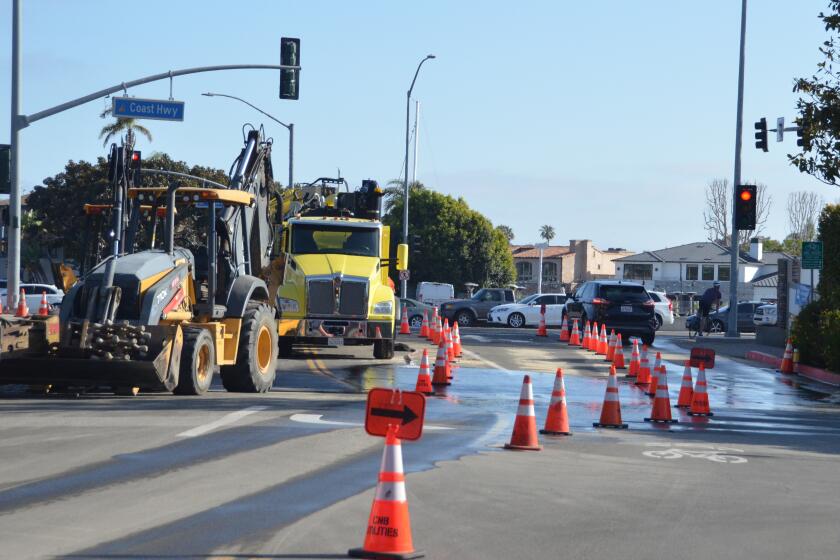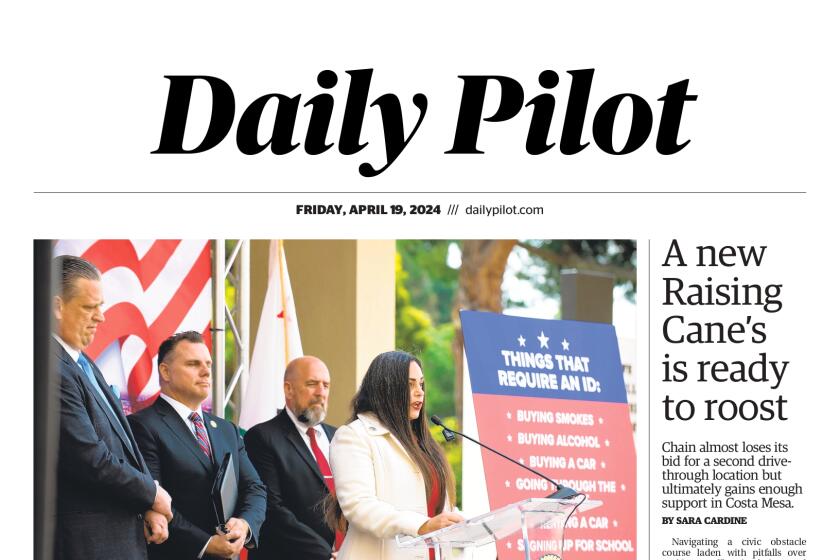Village entrance proposal revised
New plans for the “Village Entrance” are old news.
Proposals to polish up the prominent parcel that stretches along Laguna Canyon Road have come and gone for the past 30 years, shot down one or another group of folks in town.
But the elusive goal of finding a project that could be supported by a broad spectrum of the community may have been advanced Tuesday when the council added a proposal for a less-intrusive, more environmentally sensitive parking structure design without a major reduction in the public parking spaces to the Village Entrance draft environmental impact report.
“This is much better,” said Laguna Canyon Conservancy President Carolyn Wood. “Go for it.”
The alternative was inspired by a proposal submitted by former Mayor Ann Christoph that called for the construction of the parking structure around, not over, the sewer pump station on the site, and comments from Parking, Traffic and Circulation Committee Chair Vic Opincar.
“I thought from day one — day zero, that we could not build a garage over a pump station,” Councilwoman Cheryl Kinsman said. “Toni [Mayor Iseman] and Vic were on the same page and Ann came up with a design.”
Architect Alan Pullman, of Studio One Eleven, which won the design competition for the project, was asked by the council in May to explore an alternative to proposals already in the draft report that had been circulated and finalized in March.
Pullman was instructed to begin with Christoph’s proposal, but told to feel free to explore other possibilities. He presented his findings to the council at a special 4 p.m. workshop Tuesday.
“Overall, I am happy the city asked us to take another look,” Pullman said.
He described the new plan as a double helix, with sloped ramps, seen more often in urban settings, but feasible for the Village Entrance. The concept, he said, enabled him to develop a design with a smaller footprint, pushed further back from the frontage Creek Walk Park, that preserves some of the older eucalypti on the parcel, and improves traffic circulation outside and within the structure.
Pullman cautioned there are drawbacks.
The reduction in square footage from more than 70,000 square feet to less than 56,000 square feet really pushes the project to the limits of the height ordinance, Pullman said, and might mean the loss of perhaps 20 parking spaces.
Kinsman voted against adding the alternative to the draft report because she wanted 40 more parking spaces, not fewer.
But Christoph commended Pullman.
“You have done a great job,” Christoph said. “I like the fact that we can preserve the eucalyptus. It makes a big difference.”
Opincar said the council was to be congratulated for listening to its constituents, but now the time had come to get some cost estimates.
“I don’t want any surprises,” Opincar said. “We are looking at fifty or sixty million, but it is doable.”
Councilwoman Jane Egly pushed for the preliminary estimates, persuaded by Opincar.
“It would give us a better handle on what we need to do to get [the project] accomplished,” Egly said.
Councilman Kelly Boyd said the size and cost of the project warranted special oversight.
“I would like to see an oversight committee appointed to keep an eye on the project and follow it through, starting with the cost estimates.”
Councilwoman Elizabeth Schneider said she and the city manager have lobbied for Orange County Transportation participation in funding for the project.
“It won’t be just us,” said Schneider, a long-time supporter of a capacious parking structure at the Village Entrance.
Iseman, who environmentalists look to for support, made a pitch for selling the OCTA bus depot on Broadway and using the profit to help fund the Village Entrance.
Iseman and Schneider have floated the notion of a revenue bond, like the one that paid for Main Beach. It requires a guaranteed revenue stream, but not a vote of the people.
The council approved studies on parking needs, a preliminary construction staging plan and impacts on traffic, as recommended by the Planning Commission and other studies anticipated by the staff, including a updated cost estimate, and an appropriation of $250,000.
“Just because you appropriate the money doesn’t mean you have to spend it,” Frank said.
Staff will prepare cost estimates for each of the studies for council approval.
Estimated time for a construction start is 34 to 40 months. However, that could be delayed if the staff and environmental report consultant determine the proposed alternative would create a significant impact.
“Then, the draft EIR would have to be re-circulated,” Community Development Director John Montgomery said. “That would take longer.”
If no significant impacts are foreseen, the next step in the process is to prepare the required responses to comments submitted by the public and interested agencies and preparation of the mitigation monitoring program to be included in the final environmental report.
When those two documents are ready, the Planning Commission will hold its final meeting on the impact report and make recommendations to the council.
The review phase of the final report by the commission and the council could take another three months, assuming no re-circulation is required, Montgomery opined.
Once the council certifies the report as adequate, the commission and the council could start the review process for all required entitlements and the final design for the Village Entrance.
All the latest on Orange County from Orange County.
Get our free TimesOC newsletter.
You may occasionally receive promotional content from the Daily Pilot.



